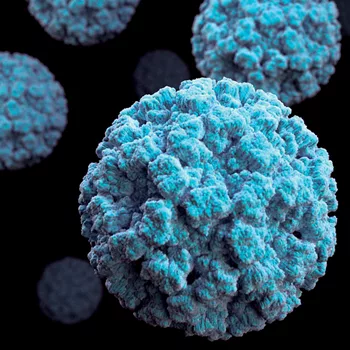Cleanup during a Norovirus Outbreak in a Foodservice Establishment

Norovirus sickens between 19 and 21 million Americans each year.[1] In humans, norovirus is spread two ways—directly by person-to-person transmission, the most common route, or indirectly through contaminated food, water, or the environment.[2] While environmental transmission is reportedly low (0.35%), emerging evidence suggests contaminated surfaces play a more important role in the spread of norovirus than previously believed.[3] In fact, according to the U.S. Centers for Disease Control and Prevention (CDC), norovirus is the number one cause of diarrhea or vomiting outbreaks spread by direct contact with an infected person or through touching a contaminated surface. This is not surprising, given that a single vomiting episode can release 30 million virus particles into the environment.[4,5] Fecal matter contains even higher numbers of particles—104 to 1011 per gram—with sick individuals producing 500 g/feces per day. Consequently, if contaminated surfaces are not properly cleaned and disinfected, these surfaces could be a source of this highly infectious virus, possibly causing or prolonging an outbreak through residual environmental contamination.[6,7]
The relationship between surfaces contaminated with vomitus/feces and norovirus outbreaks has been documented in a number of published epidemiological investigations. For example, in 1999, more than 300 people, over a 5-day period, became sick after one person vomited in the auditorium and bathroom of a concert hall.[8] In a U.S. restaurant in 2006, 364 patrons and employees exhibited symptoms of a norovirus infection after an ill line cook vomited in the kitchen.[9] During October 2009, different groups of flight attendants on the same airplane became sick after a passenger vomited on the airplane.[6] In 2012, 12 employees were infected after a toddler had a diarrheal episode in a car dealership bathroom.[10] The likelihood that vomiting/diarrheal events in food establishments could result in a norovirus outbreak prompted the U.S. Food and Drug Administration (FDA) to add a regulatory provision (2-501.11) to the 2011 Supplement of the 2009 Model Food Code, requiring establishments to have in place a vomit/diarrhea cleanup program guided by 11 elements outlined in Annex 3 of the code. It is important to note that foodservice establishments are not required to have an outbreak response program for any foodborne agents including norovirus. However, CDC has published norovirus outbreak management and disease prevention guidelines that establishments could use to inform their outbreak response, including cleanup.[11]
Limitations with Current Cleanup Protocols
Before describing outbreak cleanup protocols, it is important to first briefly discuss three limitations to the current evidence base informing outbreak cleanup protocols, which support the need for additional research to inform effective protocols. First, the lack of a reliable cell culture system for norovirus has been a barrier to the development of environmental disinfectants as mechanisms in which disinfectants work are largely unknown. These mechanisms are typically inferred through studying norovirus surrogates, such as feline calicivirus or murine norovirus. However, no one surrogate perfectly mimics human norovirus. Moreover, molecular techniques, such as quantitative reverse-transcription-polymerase chain reaction, are used as part of efficacy studies to detect and quantify the presence of surrogates before and after application of a disinfection strategy. These molecular techniques are limited as they cannot distinguish between infectious and noninfectious virus, so the true efficacy of a disinfectant against norovirus is unknown.
Secondly, the area to be cleaned is based on epidemiological not empirical evidence. Cleanup generally focuses on areas known to be contaminated with vomitus and diarrhea. An epidemiological study conducted by Evans et al.8 reported that a single vomit or diarrheal episode infected 50–70 percent of all persons within a 25-foot radius when pathogen-laden droplets became aerosolized then deposited onto surfaces in the surrounding area. The energy imparted during projectile vomiting can result in aerosol formation during emission as well as when vomitus splatters upon impact.[12,13] Because the full extent of splatter and airborne dispersion cannot be observed by the naked eye, the contaminated area can be surprisingly large. It is unlikely that cleaners would anticipate such large areas of contamination and might not effectively clean because they do not know how large of an area to clean. If viruses remain airborne and/or extend beyond the area cleaned, the duration of exposure could be increased.
Lastly, cleanup protocols typically recommend using a chlorine bleach solution (1,000–5,000 ppm) or a U.S. Environmental Protection Agency (EPA)-registered chemical disinfectant. All of these were tested on hard surfaces using norovirus surrogates; therefore, their efficacy against norovirus in general and on soft surfaces is unknown. This is a critical gap in cleanup protocols as soft surfaces, while disallowed in food production areas, can be common in dining areas in foodservice establishments. Unpublished research findings show that vomiting events frequently occur in public spaces, such as a foodservice dining room, rather than in bathrooms. While most people seek to vomit in bathrooms, this is not always possible, particularly if vomiting is unanticipated. Moreover, cleanup can be challenging on carpet, particularly after a vomiting event, because of the nature of the carpet fibers. Furthermore, using chemical disinfectants on carpet can degrade the fibers, which could be a deterrent for use. One possible solution presented by CDC and the Occupational Safety and Health Administration is steam-cleaning carpet after contamination with bodily fluids, but the efficacy of steam-cleaning carpeting has not been thoroughly tested.
Disinfectants, Not Sanitizers
CDC lists three prevention and control strategies—hand hygiene, exclusion and isolation, and environmental disinfection. The use of a chemical disinfectant is key to interrupting the spread of norovirus from contaminated surfaces during an outbreak. The Food Code defines sanitization but does not define disinfection. Both are designed to kill microorganisms but have different applications. First, sanitizers are used on food contact surfaces and soft surfaces, whereas disinfectants are used on all hard surfaces not classified as a food contact surface and all surfaces contaminated with bodily fluids. Another difference is that disinfectants are used to destroy or irreversibly inactivate the microorganisms listed on their label, which may include bacteria, fungi, and viruses but not necessarily spores. Sanitizers are used to reduce, but not necessarily eliminate, bacterial count by 5 logs or 99.999 percent. Sanitizers used on soft surfaces must reduce bacterial counts by 3 logs or 99.9 percent. Disinfectants also tend to be used at much higher concentrations and usually have a longer contact time. Sanitizers tend to be used at lower concentrations for a shorter period. FDA clearly states approved concentrations of sanitizers in its respective regulations. Too high or too low of a concentration is a violation of these regulations. EPA maintains a list of registered sanitizers and disinfectants on its website.[14] If a product is registered with the EPA and described as a sanitizer or disinfectant, it can be used in a foodservice setting as stated on the label. Check the label to determine the contact time, whether it needs to be rinsed off, and any other precautions to take when handling.
Cleanup Protocols
Note: Universal procedural steps are currently not available for cleaning up a foodservice establishment during an outbreak, making it difficult for the 70 percent of foodservice operations that are independently owned and operated. As a result, there could be multiple interpretations of how to clean up during an outbreak, potentially leading to the ineffective removal of pathogens from the environment.
Once an outbreak has been identified, the facility must heighten environmental disinfection protocols. As it might take several days for confirmation from the local regulatory authority, protocols should be put into action immediately after a suspected outbreak has been identified. While many cleanup protocols specify increasing cleaning and disinfecting during an outbreak, there is no universal standard for the number of times a facility should be cleaned per day during an outbreak. CDC does recommend increasing cleaning areas to twice a day and high-touch surfaces to three times daily. One must consider the highest traffic times in bathrooms and other areas to determine how often to clean each area. The frequency of bathroom and toilet cleaning, especially high-touch surfaces, must also be increased. Lastly, it is important to remember that textile items can also become contaminated and so must be properly cleaned.
Cleaning with a detergent alone is not sufficient to remove pathogens, so surfaces must be disinfected, not just sanitized, following cleaning (Table 1). Sodium hypochlorite (chlorine bleach) has been widely recommended to disinfect human norovirus from surfaces and its efficacy has been well documented.15–17 Chlorine bleach solution should be applied to hard, nonporous, environmental surfaces at a concentration of 1,000–5,000 ppm. As chlorine bleach may affect fabrics and other surfaces, spot-test an area before applying to any visible surface. If chlorine bleach is not used in the facility, or for surfaces that could corrode or be damaged by bleach, 80 other commercial products have been approved by EPA to be effective against norovirus. These chemicals can be dangerous if not properly prepared and applied. Follow all safety instructions and mix at the manufacturers’ recommended concentrations. A list of EPA-approved products is available at www.epa.gov/oppad001/list_g_norovirus.pdf.
Cleanup procedures that might result in aerosolization of norovirus (e.g., dry-vacuuming, dry dusting, or buffing) should not be used (Table 2). Cleaning with detergent and hot water, followed by disinfection with sodium hypochlorite or steam cleaning is preferred. Lastly, minimize air currents generated by open windows, fans, or air conditioning because they may disperse aerosols widely.

As noted above, if contaminated surfaces are not properly cleaned and disinfected, they could be a source of norovirus and possibly cause or prolong an outbreak through residual environmental contamination. By following CDC outbreak management and disease prevention guidelines, establishments can significantly enhance their outbreak response, including cleanup of the foodservice environment.
Angela M. Fraser, Ph.D., is a professor in the Department of Food, Nutrition, and Packaging Sciences at Clemson University.
References
1. Hall, AJ, et al. 2013. “Norovirus Disease in the United States.” Emerg Infect Dis 19(8):1198–1205.
2. Hall, AJ, et al. 2014. “Vital Signs: Foodborne Norovirus Outbreaks—United States, 2009–2012.” Morb Mortal Wkly Rep 63:491–495.
3. Atmar, RL, et al. 2014. “Determination of the 50% Human Infectious Dose for Norwalk Virus.” J Infect Dis 209:1016–1022.
4. Bonifait, L, et al. 2015. “Detection and Quantification of Airborne Norovirus during Outbreaks in Healthcare Facilities.” Clin Infect Dis 61:299–304.
5. Kirby, AE, et al. 2016. “Vomiting as a Symptom and Transmission Risk in Norovirus Illness: Evidence from Human Challenge Studies.” PLoS One 11:e0143759.
6. Thornley, CN, et al. 2011. “Recurring Norovirus Transmission on an Airplane.” Clin Infect Dis 53:515–520.
7. Khare, P and L Marr. 2014. “Simulation of Vertical Concentration Gradient of Influenza Viruses in Dust Resuspended by Walking.” Indoor Air 25:428–440.
8. Evans, MR, et al. 2001. “An Outbreak of Viral Gastroenteritis Following Environmental Contamination at a Concert Hall.” Epidemiol Infect 129:355–360.
9. U.S. Centers for Disease Control and Prevention. 2007. “Norovirus Outbreak Associated with Ill Foodservice Workers—Michigan, January–February 2006.” Morb Mortal Wkly Rep 56(46):1212–1216.
10. Repp, KK, et al. 2013. “A Norovirus Outbreak Related to Contaminated Surfaces.” J Infect Dis 208(2):295–298.
11. Hall, A, et al. 2011. “Updated Norovirus Outbreak Management and Disease Prevention Guidelines.” Morb Mortal Wkly Rep 60(RR03):1–15.
12. Booth, CM. 2014. “Vomiting Larry: A Simulated Vomiting System for Assessing Environmental Contamination from Projectile Vomiting Related to Norovirus Infection.” J Infect Prev 15(5):176–180.
13. Tung-Thompson, G, et al. 2015. “Aerosolization of a Human Norovirus Surrogate, Bacteriophage, MS2, during Simulated Vomiting.” PLoS One 10:e0134277.
14. www.epa.gov/opp00001/pestlabels/.
15. Doultree, JC, et al. 1999. “Inactivation of Feline Calicivirus, a Norwalk Virus Surrogate.” J Hosp Infect 41(1):51–57.
16. Duizer, E, et al. 2004. “Inactivation of Caliciviruses.” Appl Environl Microbiol 70:4538–4543.
17. Girard, M, et al. 2010. “Attachment of Noroviruses to Stainless Steel and Their Inactivation Using Household Disinfectants.” J Food Prot 73:400–404.
Looking for quick answers on food safety topics?
Try Ask FSM, our new smart AI search tool.
Ask FSM →







